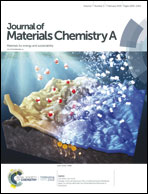An ultrathin and highly porous silica nanochannel membrane: toward highly efficient salinity energy conversion†
Abstract
Artificial solid-state nanochannels are capable of regulating unipolar ion transport in their confined space and thus converting the Gibbs free energy stored in the salinity gradients to electricity. In order to achieve a large conversion efficiency, highly ion-selective and permeable nanochannel membranes are inevitably desired. In this work we report the salinity energy conversion using an ultrathin silica isoporous membrane (SIM, ∼90 nm in thickness) that consists of straight, uniform and close packed nanochannels (diameter, 2–3 nm; pore density, ∼4 × 1012 cm−2, corresponding to a porosity of 16.7%). Thanks to its unique structure and negatively charged surface, the SIM displayed excellent cation selectivity and meanwhile preserved a high ionic flux, and was capable of harnessing the osmotic energy efficiently upon mixing artificial seawater and river water. We rationalized the ion distribution inside the nanochannels in the presence of salinity gradients and the effect of the channel length on the energy conversion efficiency by finite element simulations. The simulated results suggest that short nanochannels with an ultrasmall dimeter of ∼2.3 nm and a length of ∼100 nm possess excellent cation selectivity. Both experimental and theoretical results suggest that the SIM is a highly potential material in salinity energy conversion.



 Please wait while we load your content...
Please wait while we load your content...